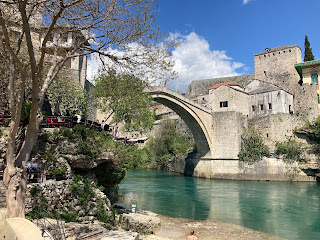The Dalmatian Coast is extraordinarily beautiful, with many small islands just off shore. Along one bay, our tour leader stopped the bus and explained that the ecosystem of this particular bay made it ideal for the farming of oysters. We walked a short way to where a woman was selling fresh oysters. We got a lesson in oyster farming, and got to sample fresh oysters on the half shell.
The southernmost section of Croatia, where Dubrovnik is located, is cut off from the rest of the country by a short stretch of about 20 miles where Bosnia-Herzegovina owns the coastline. Croatia contracted with the Chinese to build a bridge that would allow going around this.
The bridge is finished, but the contractors building the road to connect to the bridge have been slow. So we had to stop, go through passport control, then stop again to leave Bosnia and re-enter Croatia -- only to leave Croatia once again and re-enter Bosnia-Herzegovina an hour or so later.
Our lunch stop was in the city of Mostar. And lunch was a traditional Bosnian meal of chicken kebabs. It has a name, but we couldn't pronounce it. Dessert was Hurmasica, a sweet pastry very similar to some we have had in Turkey. It was served with Bosnian coffee, which is as strong as Turkish coffee, but even heavier on the sugar.
Mostar was much in the news in the early 1990s during the war here. A river runs through the city, and a very famous high arched bridge built here in the 1500s was destroyed. It has been rebuilt to Medieval specifications using stone from the same quarry and the original, but it's still new.
There is a Croat side of the river and a Bosniac side. War damage is still visible on both sides, and some neighbors still refuse to cross the bridge. But one tradition is that young men still stand on the bridge in swimsuits, offering to dive off for the right offer of cash. One young man approached our group and tried to get us to put up four Euros each for a dive, but we declined. We saw no divers while there.
We drove through some very beautiful countryside along a winding river. At one point, we came down into a wide valley where orange groves spread as far as the eye could see. In other spots, the mountains themselves were the scenery.
We made a bathroom stop near a place where General Tito had battled Nazis during WW II. The battle was made into a movie in the early 1970s, with Richard Burton playing the role of Tito. "The Battle of Sutjeska" was filmed on location here.
Just outside of Sarajevo, we finally got onto a highway that approximated a modern interstate, and made better time. Here, the topography changed, and we saw a number of shepherds in fields with their dogs, herding sheep.
Bosnia has not been as prosperous as Croatia, and thus recovery from the war has been slower. We saw a number of bombed out buildings that have yet to be rebuilt or repaired. We also saw that many people continue to live in dreary-looking Soviet-style apartment high rises left over from the Tito days of the former Yugoslavia.
Expectations were low for our hotel, as our tour leader had been careful to let us know not to expect anything as nice as the place we stayed in Dubrovnik. But we think she over-stated the issue, because the room was quite nice.
Our evening meal was at a small restaurant on the Muslim side of Sarajevo, not far from our hotel. We ate Cevapi, spicy sausages stuffed into a grilled flatbread called lepinja -- sort of like a pita pocket -- with a clotted cream spread and eggplant relish. Dessert was a steamed apple dish called tufahija, also very sweet.











No comments:
Post a Comment